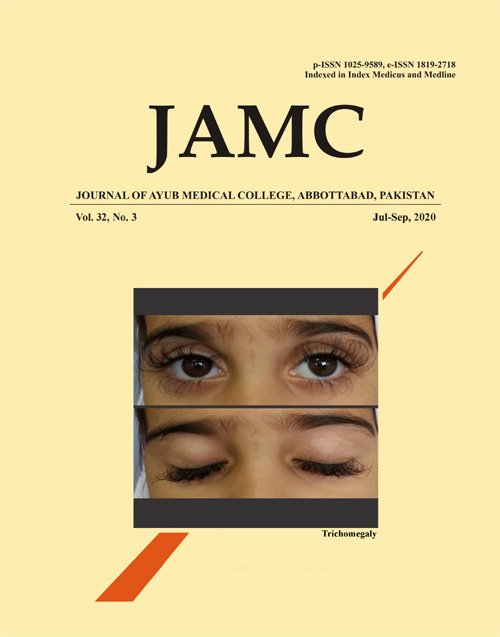PROTOCOLS OF TREATMENT OF MENINGITIS IN MEDICAL DEPARTMENT: ARE THERE ANY?
Abstract
Background: Meningitis, whether viral or bacterial is associated with high mortality rate and risk of severe lifelong disability. Early antibiotics administration and favourable outcomes have been demonstrated by previous studies. The purpose of the study was to evaluate whether the patients with suspected meningitis in general medicine department of Ayub Teaching Hospital Abbottabad were being managed according to protocols. Methods: This cross-sectional study was carried out in the Medical Department of Ayub Teaching Hospital Abbottabad from March 2018-March 2019 in which data was retrospectively collected from the hospital records of all patients with suspected meningitis admitted in Medical Ward. SPSS version 20.0 was used for data analysis. Results: Out of 41 patients in the study 19 (51.74%) were male. Viral encephalitis accounted for 23 (56.1%) tuberculous meningitis for 14 (34.1%), and 4 (9.8%) patients had septic meningitis. Lumbar puncture for CSF examination was performed in 38 (92.7%). Out of 41 patients, 19 (46.3%) received a combination of Ceftriaxone, Acyclovir and Dexamethasone, 16 (39.0%) patients received anti tuberculous treatment (ATT), Dexamethasone and Streptomycin combination, 3 (7.35%) patients were given Ceftriaxone (2g) and Dexamethasone and 1 ( 2.45%) patient was given a combination of Ceftriaxone(2gm) along with Vancomycin (1gm) and Dexamethasone; while 2(4.9%) patients were given a combination of Acycolvir and Dexamethasone. Conclusion: This study identified practice gaps in the management of patients with suspected meningitis according to guidelines, as lumbar puncture and CSF-RE were not timely done and proper laboratory records were not maintained. Secondly blood culture facilities were not available in the hospital.Keywords: Tuberculous Meningitis; Viral Encephalitis; Lumbar PunctureReferences
Zunt JR, Kassebaum NJ, Blake N, Glennie L, Wright C, Nichols E, et al. Global, regional, and national burden of meningitis, 1990–2016: a systematic analysis for the Global Burden of Disease Study 2016. Lancet Neurol 2018;17(12):1061–82.
van de Beek D, de Gans J, Spanjaard L,Weisfelt M, Reitsma JB, Vermeulen M. Clinical features and prognostic factors in adults with bacterial meningitis. N Engl J Med 2004;351(18):1849–59.
McGill F, Heyderman RS, Michael BD, Defres S, Beeching NJ, Borrow R, et al. The UK joint specialist societies guideline on the diagnosis and management of acute meningitis and meningococcal sepsis in immunocompetent adults. J Infect 2016;72(4):405–38.
Koster-Rasmussen R, Korshin A, Meyer CN. Antibiotic treatment delay and outcome in acute bacterial meningitis. J Infect 2008;57(6):449–54.
Hasbun RO. Cerebrospinal fluid in central nervous system infections. Chapter 2. In: Infections of the Central Nervous System. 4th ed. Edited by Scheld, Whitley & Marra: 2014; p.4–23.
WHO. Defeating meningitis by 2030: baseline situation analysis. Geneva: World Health Organization; 2019.
Miller R, Houlberg K. Meningitis service-age personnel. J Royal Nav Med Serv 2015;101(1):63–8.
WHO. Meningococcal meningitis: Fact sheet 2017. [Internet]. World Health Organization updated December 2017 [cited 2017 Nov 9] Available from: http://www.who.int/mediacentre/factsheets/fs141/en/
WHO. Number of suspected meningitis cases and deaths reported 2010 epidemiological season. [Internet]. World Health Organization [cited 2017 Nov 9]. Available from: https://www.who.int/gho/epidemic_diseases/meningitis/suspected_cases_deaths_text/en/
Gounder PP, Zulz T, Desai S, Stenz F, Rudolph K, Tsang R, et al. Epidemiology of bacterial meningitis in the North American Arctic, 2000–2010. J Infect 2015;71(2):179–87.
Pelton SI. The Global Evolution of Meningococcal Epidemiology Following the Introduction of Meningococcal Vaccines. J Adolesc Health 2016;59(2 Suppl):S3–11.
de Ory F, Avellon A, Echevarria JE, Sacnhez-Seco MP, Trallero G, Cabrerizo M, et al. Viral Infections of the central nervous system in Spain: a prospective study. J Med Virol 2013;85(5):554–62.
Landry ML, Greenwold J, Vikram HR. Herpes simplex type-2 meningitis: presentation and lack of standardized therapy. Am J Med 2009;122(7):688–91.
Hasbun R, Rosenthal N, Balada-Llasat JM, Chung J, Duff S, Bozzette S, et al. Epidemiology of Meningitis and Encephalitis in the United States, 2011-2014. Clin Infect Dis 2017;65(3):359–63.
van de Beek D, Cabellos C, Dzupova O, Esposito S, Klein M, Kloek AT, et al. ESCMID guideline: diagnosis and treatment of acute bacterial meningitis. Clin Microbiol Infect 2016;22(Suppl 3):S37–62.
Modi M, Goyal MK, Jain A, Sawhney SS, Sharma K, Vyas S, et al. Tuberculous meningitis: Challenges in diagnosis and management: Lessons learnt from Prof. Dastur's article published in 1970. Neurol India 2018;66(6):1550–71.
van de Beek D, de Gans J, Tunkel AR, Wijdicks EF. Community-acquired bacterial meningitis in adults. N Engl J Med 2006;354(1):44–53.
Namani SA, Koci RA, Qehaja-Bucaj E, Ajazaj-Berisha L, Mehmeti M. The epidemiology of bacterial meningitis in Kosovo. J Infect Dev Ctries 2014;8(7):823–30.
Published
Issue
Section
License
Journal of Ayub Medical College, Abbottabad is an OPEN ACCESS JOURNAL which means that all content is FREELY available without charge to all users whether registered with the journal or not. The work published by J Ayub Med Coll Abbottabad is licensed and distributed under the creative commons License CC BY ND Attribution-NoDerivs. Material printed in this journal is OPEN to access, and are FREE for use in academic and research work with proper citation. J Ayub Med Coll Abbottabad accepts only original material for publication with the understanding that except for abstracts, no part of the data has been published or will be submitted for publication elsewhere before appearing in J Ayub Med Coll Abbottabad. The Editorial Board of J Ayub Med Coll Abbottabad makes every effort to ensure the accuracy and authenticity of material printed in J Ayub Med Coll Abbottabad. However, conclusions and statements expressed are views of the authors and do not reflect the opinion/policy of J Ayub Med Coll Abbottabad or the Editorial Board.
USERS are allowed to read, download, copy, distribute, print, search, or link to the full texts of the articles, or use them for any other lawful purpose, without asking prior permission from the publisher or the author. This is in accordance with the BOAI definition of open access.
AUTHORS retain the rights of free downloading/unlimited e-print of full text and sharing/disseminating the article without any restriction, by any means including twitter, scholarly collaboration networks such as ResearchGate, Academia.eu, and social media sites such as Twitter, LinkedIn, Google Scholar and any other professional or academic networking site.









